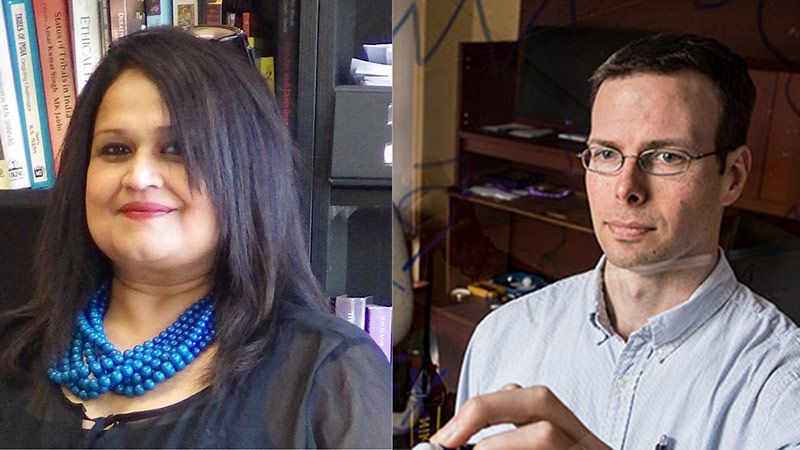Interdisciplinary research team aims to create better outcomes for people with spinal cord injuries
Author: Jeremy Elder-Jubelin
Posted on Jun 5, 2024
Category: UNB Fredericton

A group of researchers is combining their broad range of talents to take on one of our most expensive and life-altering sets of injuries.
Together, they will bridge the communication and knowledge gaps between disciplines in the hopes of creating better outcomes for those experiencing spinal cord injuries (SCI). To help support their endeavour, the research team has been awarded $250,000 in research funding by the Government of Canada, as part of the more than $92 million in research support through the New Frontiers in Research Fund. The funding was announced on June 3.
The research team says spinal cord injury is one of the most devastating health conditions – one that is seeing a global rise in incidence, prevalence and years lived with disability. The post-injury journey is difficult and uncertain, and very particular to the individual because of the complexity of the biological systems involved, the scope and intensity of its impact on daily life, and the broad range of possible rehabilitation interventions.
However, current rehabilitation plans are often derived from aggregate data and research that loses that individual focus. And beyond that, the researchers say, an individual’s own story and context shape their outcomes in ways that simply can’t be captured by statistical summaries.
“A critical gap in SCI rehabilitation is that current practices fail to capture the intersectional needs, strengths and resources of individuals and community stakeholders,” said Dr. Jon Sensinger, a professor of electrical and computer engineering who specializes in biomedical engineering, and one of the project’s principal investigators.
“By this we mean: the perspectives, lived experiences and daily life contexts of people that derive from their individual collection of identity traits is an important, but as yet poorly understood, part of rehabilitation processes and outcomes. This is especially the case for those whose voice is underrepresented – women, Indigenous, socioeconomically disadvantaged, racialized, 2SLGBTQIA+ and others.”
To understand these intersectional perspectives, and to use them to create positive outcomes for people undertaking SCI rehabilitation, the research team will be using a novel approach that bridges social sciences, natural sciences and engineering and health sciences.
That approach starts with two major sources of techniques and insight: medical anthropology and artificial intelligence.
That first domain is an area of expertise for the project’s second principal investigator, Dr. Koumari Mitra, a professor of anthropology who specializes in medical anthropology.
“Medical anthropology studies these human health problems and healing systems in their broad social and cultural contexts, often using ethnography — a distinctive research method that helps us develop a detailed analysis of cultural attributes, behaviour and expression,” she said.
“Of particular importance for this project are explanatory models of illness, which enable us to understand the way people perceive, interpret and respond to illness across multiple groups: patients, caregivers, health professionals and more.”
In these models, the researchers hope to incorporate input from patients, clinicians, decision makers, caregivers and other stakeholders.
Then, using these models as sources of information for the costs, benefits, interactions and goals of these stakeholders, the research team will work to develop what they call a ‘curiosity-driven algorithmic framework.’
The curiosity element refers to the algorithm’s focus creating the best long-term outcome, and also on learning and discovery, even if it means a suboptimal short-term outcome.
“A good analogy is how you might choose to tap the brakes on an icy day to see how your car responds,” said Sensinger. “The action appears suboptimal in the short term, but the knowledge that it gives you is worth it in the long term.”
A successful framework will enable personalized outcomes that balance costs and rewards. To achieve this, they’ll use an approach called optimal control theory, which works to identify the lowest cost required to achieve the greatest reward.
The project’s strengths, according to the researchers, stem from its creative, multidisciplinary approach to the problem. To fully take advantage of that strength, the assembled team includes many other specialists.
Co-investigators on the project include Dr. physiatrist Colleen O’Connell, MD; Dr. Shelley Doucet, professor of nursing and health sciences; Dr. Dylan Spicker, assistant professor of mathematics and statistics; Dr. Chris McGibbon, professor of kinesiology; and Dr. Erik Scheme, associate professor of electrical and computer engineering.
The team also includes physiotherapist Luke Dillman, occupational therapist Wendy Hill, biomedical engineer Katie Wilson, all part of UNB’s Institute for Biomedical Engineering, and broader members of the community such as the Praxis Spinal Cord Institute, an advocacy group, and persons with lived experience.
